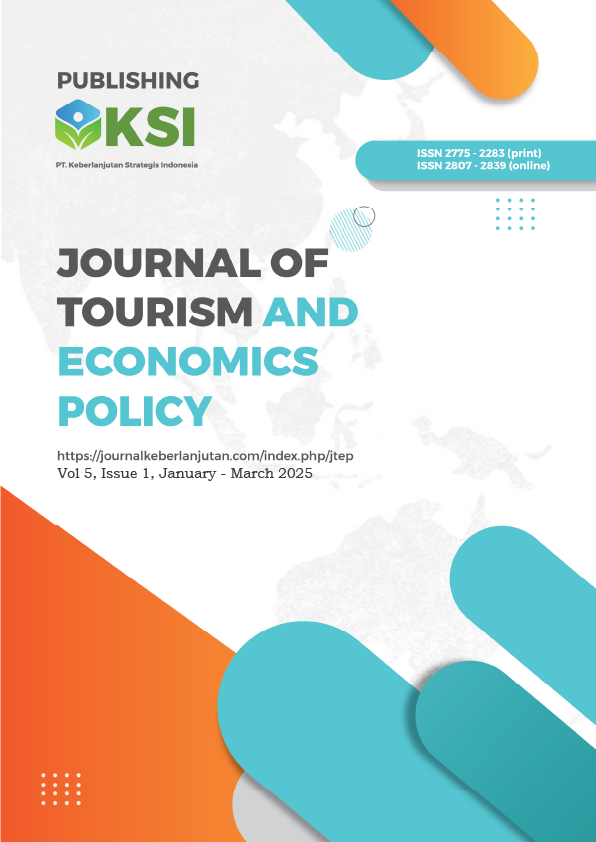Tourism Susceptibility and Sustainability
DOI:
https://doi.org/10.38142/jtep.v5i2.1302Keywords:
Tourism susceptibility, Velocity of money, sustainabilityAbstract
Tourism lies at the very bedrock of human civilization, tourism is no longer a means to merely satiate ones basic needs, as it fulfilled needs for water, fodder, food etc to human being and accompanying pets in the ancient time. Now a days it is being presented as a well crafted product. Nonetheless tourism as a product is quite different when compared to factory outlets. This paper is an attempt to develop a mathematical model and introduces measure of tourism susceptibility, and about how tourism as a products is carved out of integrating various services viz. travel, accommodation, fitness, cultural, adventurism, health, ecotourism, pilgrimage sites etc. Through this model stages of growth of tourism and all its integrands could be efficiently and effectively manages and risk could be minimized, and welfare of hosts could be assured. It analyses the saturation point i.e. the maximum growth of tourism until physical carrying capacity is being achieved. It estimates that velocity of money, shows that it increases as tourism grows provided ample physical infrastructure to support it at destination is easily available. Expression for Seigniorage revenue out of tourism is being established, This model also predicts that tourism gain could be realized and sustained through monetary feedback mechanism responsive to coupling effects, and sustainable development of natural environment.
References
Butler, R. W. (1980). The Concept of a Tourist Area Cycle of Evolution: Implications for Management of Resources. Canadian geographer, 24(1), 5-12. https://doi.org/10.1111/j.1541-0064.1980.tb00970.x
Canto, V. A. (2018). Economic Disturbances and Equilibrium in an Integrated Global Economy: Investment Insights and Policy Analysis. Academic Press.
de Rozari, R. P. E., Polinggomang, Y., & Fanggidae, A. H. (2024). Sustainable Ecotourism and Creative Economy Development Model with Local Wisdom Perspective. Journal of Tourism Economics and Policy, 4(4), 388-404. https://doi.org/10.38142/jtep.v4i4.1124
Durkheim, E. (2016). The Elementary Forms of Religious Life. In Social theory re-wired (pp. 52-67). Routledge.
Gal, Y., Gal, A., & Hadas, E. (2010). Coupling Tourism Development and Agricultural Processes in a Dynamic Environment. Current Issues in Tourism, 13(3), 279-295. https://doi.org/10.1080/13683500903141147
Griffin, K. A., & Raj, R. (2017). The Importance of Religious Tourism and Pilgrimage: Reflecting on Definitions, Motives and Data. International Journal of Religious Tourism and Pilgrimage.
Haris, A., Samosir, H. E., & Lubis, S. H. (2023). Marketing Communications as Strategy Expanding Market Share in Era 4.0. International Journal of Social Science and Business, 7(1), 188–198. https://doi.org/10.23887/ijssb.v7i1.53535
Kinley, D. (1904). Money: A Study of the Theory of the Medium of Exchange. Macmillan.
Liao, K. C., Yue, M. Y., Sun, S. W., Xue, H. B., Liu, W., Tsai, S. B., & Wang, J. T. (2018). An Evaluation of Coupling Coordination Between Tourism and Finance. Sustainability, 10(7), 2320. https://doi.org/10.3390/su10072320
Liu, C. (2019). Coupling Model of Tourist Scenic Spot Development and Ecological Environment. Ekoloji Dergisi, (108).
Maslow, A. H. (1943). A Theory of Human Motivation. Psychological review, 50(4), 370. https://doi.org/10.1037/h0054346
Ndung'u, N. (2018). The M-Pesa Technological Revolution for Financial Services in Kenya: A Platform for Financial Inclusion. In Handbook of blockchain, digital finance, and inclusion, volume 1 (pp. 37-56). Academic Press. https://doi.org/10.1016/B978-0-12-810441-5.00003-8
Sharpley, R., & Telfer, D. J. (2014). Tourism and development: Concepts and issues. Multilingual Matters. https://doi.org/10.21832/9781845414740
UNWTO. (2011). World Tourism Barometer. Interim Update August 2011, Madrid: United Nations World Tourism Organisation
UNWTO. (2012). Religious Tourism in Asia and Pacific, ISBN-13: 978-92-844-1380-5.
UN, WTO (2010). International Recommendations for Tourism Statistics 2008, New York.
Widiatmoko, J., Indarti, M. G. K., & Ifada, L. M. (2023). How Temporary Book Tax Differences Influence Earning Quality? An Integrated Analysis with Investment Opportunity Set and Human Capital. JIA (Jurnal Ilmiah Akuntansi), 8(1), 225–244. https://doi.org/10.23887/jia.v8i1.60842
Williams, A., & Shaw, G. (1988). Ιntroduction: Tourism and Uneven Economic Development.
Word Bank (1991). World Development Report 1991: The Challenges of Development, New York: Oxford University Press.
Downloads
Published
Issue
Section
License
Copyright (c) 2025 Rajesh Kumar MAURYA

This work is licensed under a Creative Commons Attribution-NonCommercial 4.0 International License.
Creative Commons Attribution-NonCommercial 4.0 International License.





















